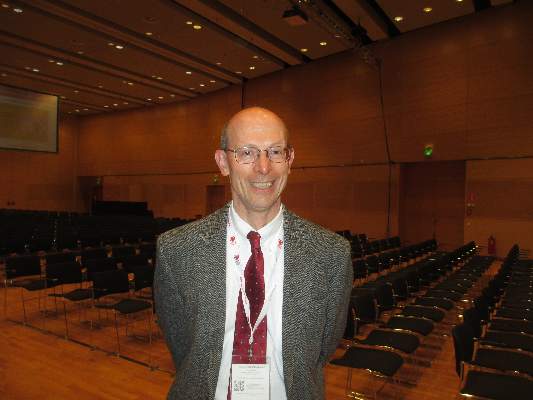User login
VIENNA – Coronary CT followed by some form of functional stress imaging when needed now stands as the most cost-effective way to screen patients with chest pain regardless of whether the pain is chronic or acute onset.
Results from a 2011 analysis established the cost efficacy of cardiac CT followed by stress imaging for patients with positive CT results for acute chest-pain patients at low or intermediate risk for coronary disease, and no data reported since then have changed that conclusion, Dr. Thomas H. Marwick said at the annual meeting of the European Association of Cardiovascular Imaging.
Results from a new analysis presented in a separate report at the meeting showed the superior cost effectiveness of the same approach for patients with stable chest pain who are at low or intermediate risk for having coronary disease, said Dr. Steffen E. Petersen, professor and head of the Centre for Advanced Cardiovascular Imaging at the William Harvey Research Institute in London.
“We did a cost-effectiveness analysis that took into account the cost of results that lead to additional testing and the cost when people return later with symptoms and need more testing. We compared about 15 different strategies, and found it was best to start with CT and if that was positive then do a functional test like stress echocardiography, stress single-photon emission CT (SPECT), or stress MRI. CT followed by stress echo seemed most cost effective, but using stress SPECT or MRI was not very different; they can all be used after CT,” Dr. Petersen said in an interview.
His analysis, which modeled the costs for a man or woman aged 60 years with a 30% probability of having coronary artery disease, showed that a testing strategy of coronary CT followed by stress echo for patients with a significant coronary stenosis cost roughly £32,000 (about $50,000) for each quality-adjusted life year gained.
Choice of the follow-up, functional test for patients with stable chest pain who show at least 50% stenosis in at least one segment of their coronary vessels on CT primarily depends on other considerations, such as local experience using the various functional-imaging methods as well as how long a patient might need to wait until the stress test is done, Dr. Petersen said. For higher-risk patients who likely have significant coronary artery disease, the cost effectiveness of an initial CT examination drops below that of the alternative approach of referring the patient directly for a functional test with no initial CT. He advised clinicians to assess a patient’s pretest probability of having coronary artery disease with a tool such as the modified Diamond-Forrester model (Eur. Heart J. 2011;32:1316-30).
Dr. Petersen and his associates used already-published data from the United States, United Kingdom, and The Netherlands that documented the positive and negative predictive values of various imaging methods used alone or in tandem as well as the impact of each method on additional testing, delays while testing proceeds, and eventual patient outcomes. “We basically all agreed on our model, and then we ran the model and looked at the results,” he said.
“I think our findings would change practice in a lot of places,” he added. For patients with stable disease access to various imaging methods is usually not an issue because stable patients can receive a referral to a facility with that method available.
Dr. Marwick asserted that cardiac CT followed by functional testing with SPECT for patients with an indeterminate CT result remains the most cost-effective way to screen a chest-pain patient who presents at an emergency department with a history and physical findings consistent with a low or intermediate risk of having coronary disease. He and his associates documented the consistent cost effectiveness of CT followed by SPECT in patients with a coronary artery disease prevalence of anywhere from 2% to 30% in a 2011 report (J. Am. Coll. Cardiol. Img. 2011;4:549-56). A big reason why CT first is so cost effective is because of its very high negative predictive value – its ability to reliably rule out patients who do not have significant coronary disease.
“It is very hard to overcome the cost effectiveness of CT for chest pain because of its very high predictive value, and because you can use it to study patients early,” said Dr. Marwick, professor and director of the Menzies Institute for Medical Research, University of Tasmania in Hobart, Australia. “Early CT can reduce the patient’s length of stay in the emergency department while avoiding the risk of sending someone home who is having a myocardial infarction,” Dr. Marwick said in an interview. Although his analysis showed that stress SPECT was the most cost-effective option for follow-up testing of a patient with an equivocal CT result, “it could be any functional test” because they all have nearly the same performance, he added. The other options are again stress echo or stress MRI.
“If a patient has chest pain and goes directly to CT the negative predictive value is so high that more than half the patients can safely go straight home. I’m not a big fan of CT, but this is what the numbers show,” he said
Dr. Marwick acknowledged that testing a patient’s blood level of troponin using a high-sensitivity assay might soon supplant CT, but for the time being high-sensitivity troponin remain too non specific, he said. A retrospective, Swedish study reported at the 2014 annual meeting of the American College of Cardiology documented that a high-sensitivity troponin assay could rule out myocardial infarction among patients presenting with chest pain at an emergency department with a negative predictive accuracy of nearly 100%. But at that time one expert commented that proof of the clinical utility of a high-sensitivity troponin assay for emergency chest pain patients needed validation in a well-designed, prospective trial.
Dr. Petersen and Dr. Marwick had no disclosures.
On Twitter @mitchelzoler
VIENNA – Coronary CT followed by some form of functional stress imaging when needed now stands as the most cost-effective way to screen patients with chest pain regardless of whether the pain is chronic or acute onset.
Results from a 2011 analysis established the cost efficacy of cardiac CT followed by stress imaging for patients with positive CT results for acute chest-pain patients at low or intermediate risk for coronary disease, and no data reported since then have changed that conclusion, Dr. Thomas H. Marwick said at the annual meeting of the European Association of Cardiovascular Imaging.
Results from a new analysis presented in a separate report at the meeting showed the superior cost effectiveness of the same approach for patients with stable chest pain who are at low or intermediate risk for having coronary disease, said Dr. Steffen E. Petersen, professor and head of the Centre for Advanced Cardiovascular Imaging at the William Harvey Research Institute in London.
“We did a cost-effectiveness analysis that took into account the cost of results that lead to additional testing and the cost when people return later with symptoms and need more testing. We compared about 15 different strategies, and found it was best to start with CT and if that was positive then do a functional test like stress echocardiography, stress single-photon emission CT (SPECT), or stress MRI. CT followed by stress echo seemed most cost effective, but using stress SPECT or MRI was not very different; they can all be used after CT,” Dr. Petersen said in an interview.
His analysis, which modeled the costs for a man or woman aged 60 years with a 30% probability of having coronary artery disease, showed that a testing strategy of coronary CT followed by stress echo for patients with a significant coronary stenosis cost roughly £32,000 (about $50,000) for each quality-adjusted life year gained.
Choice of the follow-up, functional test for patients with stable chest pain who show at least 50% stenosis in at least one segment of their coronary vessels on CT primarily depends on other considerations, such as local experience using the various functional-imaging methods as well as how long a patient might need to wait until the stress test is done, Dr. Petersen said. For higher-risk patients who likely have significant coronary artery disease, the cost effectiveness of an initial CT examination drops below that of the alternative approach of referring the patient directly for a functional test with no initial CT. He advised clinicians to assess a patient’s pretest probability of having coronary artery disease with a tool such as the modified Diamond-Forrester model (Eur. Heart J. 2011;32:1316-30).
Dr. Petersen and his associates used already-published data from the United States, United Kingdom, and The Netherlands that documented the positive and negative predictive values of various imaging methods used alone or in tandem as well as the impact of each method on additional testing, delays while testing proceeds, and eventual patient outcomes. “We basically all agreed on our model, and then we ran the model and looked at the results,” he said.
“I think our findings would change practice in a lot of places,” he added. For patients with stable disease access to various imaging methods is usually not an issue because stable patients can receive a referral to a facility with that method available.
Dr. Marwick asserted that cardiac CT followed by functional testing with SPECT for patients with an indeterminate CT result remains the most cost-effective way to screen a chest-pain patient who presents at an emergency department with a history and physical findings consistent with a low or intermediate risk of having coronary disease. He and his associates documented the consistent cost effectiveness of CT followed by SPECT in patients with a coronary artery disease prevalence of anywhere from 2% to 30% in a 2011 report (J. Am. Coll. Cardiol. Img. 2011;4:549-56). A big reason why CT first is so cost effective is because of its very high negative predictive value – its ability to reliably rule out patients who do not have significant coronary disease.
“It is very hard to overcome the cost effectiveness of CT for chest pain because of its very high predictive value, and because you can use it to study patients early,” said Dr. Marwick, professor and director of the Menzies Institute for Medical Research, University of Tasmania in Hobart, Australia. “Early CT can reduce the patient’s length of stay in the emergency department while avoiding the risk of sending someone home who is having a myocardial infarction,” Dr. Marwick said in an interview. Although his analysis showed that stress SPECT was the most cost-effective option for follow-up testing of a patient with an equivocal CT result, “it could be any functional test” because they all have nearly the same performance, he added. The other options are again stress echo or stress MRI.
“If a patient has chest pain and goes directly to CT the negative predictive value is so high that more than half the patients can safely go straight home. I’m not a big fan of CT, but this is what the numbers show,” he said
Dr. Marwick acknowledged that testing a patient’s blood level of troponin using a high-sensitivity assay might soon supplant CT, but for the time being high-sensitivity troponin remain too non specific, he said. A retrospective, Swedish study reported at the 2014 annual meeting of the American College of Cardiology documented that a high-sensitivity troponin assay could rule out myocardial infarction among patients presenting with chest pain at an emergency department with a negative predictive accuracy of nearly 100%. But at that time one expert commented that proof of the clinical utility of a high-sensitivity troponin assay for emergency chest pain patients needed validation in a well-designed, prospective trial.
Dr. Petersen and Dr. Marwick had no disclosures.
On Twitter @mitchelzoler
VIENNA – Coronary CT followed by some form of functional stress imaging when needed now stands as the most cost-effective way to screen patients with chest pain regardless of whether the pain is chronic or acute onset.
Results from a 2011 analysis established the cost efficacy of cardiac CT followed by stress imaging for patients with positive CT results for acute chest-pain patients at low or intermediate risk for coronary disease, and no data reported since then have changed that conclusion, Dr. Thomas H. Marwick said at the annual meeting of the European Association of Cardiovascular Imaging.
Results from a new analysis presented in a separate report at the meeting showed the superior cost effectiveness of the same approach for patients with stable chest pain who are at low or intermediate risk for having coronary disease, said Dr. Steffen E. Petersen, professor and head of the Centre for Advanced Cardiovascular Imaging at the William Harvey Research Institute in London.
“We did a cost-effectiveness analysis that took into account the cost of results that lead to additional testing and the cost when people return later with symptoms and need more testing. We compared about 15 different strategies, and found it was best to start with CT and if that was positive then do a functional test like stress echocardiography, stress single-photon emission CT (SPECT), or stress MRI. CT followed by stress echo seemed most cost effective, but using stress SPECT or MRI was not very different; they can all be used after CT,” Dr. Petersen said in an interview.
His analysis, which modeled the costs for a man or woman aged 60 years with a 30% probability of having coronary artery disease, showed that a testing strategy of coronary CT followed by stress echo for patients with a significant coronary stenosis cost roughly £32,000 (about $50,000) for each quality-adjusted life year gained.
Choice of the follow-up, functional test for patients with stable chest pain who show at least 50% stenosis in at least one segment of their coronary vessels on CT primarily depends on other considerations, such as local experience using the various functional-imaging methods as well as how long a patient might need to wait until the stress test is done, Dr. Petersen said. For higher-risk patients who likely have significant coronary artery disease, the cost effectiveness of an initial CT examination drops below that of the alternative approach of referring the patient directly for a functional test with no initial CT. He advised clinicians to assess a patient’s pretest probability of having coronary artery disease with a tool such as the modified Diamond-Forrester model (Eur. Heart J. 2011;32:1316-30).
Dr. Petersen and his associates used already-published data from the United States, United Kingdom, and The Netherlands that documented the positive and negative predictive values of various imaging methods used alone or in tandem as well as the impact of each method on additional testing, delays while testing proceeds, and eventual patient outcomes. “We basically all agreed on our model, and then we ran the model and looked at the results,” he said.
“I think our findings would change practice in a lot of places,” he added. For patients with stable disease access to various imaging methods is usually not an issue because stable patients can receive a referral to a facility with that method available.
Dr. Marwick asserted that cardiac CT followed by functional testing with SPECT for patients with an indeterminate CT result remains the most cost-effective way to screen a chest-pain patient who presents at an emergency department with a history and physical findings consistent with a low or intermediate risk of having coronary disease. He and his associates documented the consistent cost effectiveness of CT followed by SPECT in patients with a coronary artery disease prevalence of anywhere from 2% to 30% in a 2011 report (J. Am. Coll. Cardiol. Img. 2011;4:549-56). A big reason why CT first is so cost effective is because of its very high negative predictive value – its ability to reliably rule out patients who do not have significant coronary disease.
“It is very hard to overcome the cost effectiveness of CT for chest pain because of its very high predictive value, and because you can use it to study patients early,” said Dr. Marwick, professor and director of the Menzies Institute for Medical Research, University of Tasmania in Hobart, Australia. “Early CT can reduce the patient’s length of stay in the emergency department while avoiding the risk of sending someone home who is having a myocardial infarction,” Dr. Marwick said in an interview. Although his analysis showed that stress SPECT was the most cost-effective option for follow-up testing of a patient with an equivocal CT result, “it could be any functional test” because they all have nearly the same performance, he added. The other options are again stress echo or stress MRI.
“If a patient has chest pain and goes directly to CT the negative predictive value is so high that more than half the patients can safely go straight home. I’m not a big fan of CT, but this is what the numbers show,” he said
Dr. Marwick acknowledged that testing a patient’s blood level of troponin using a high-sensitivity assay might soon supplant CT, but for the time being high-sensitivity troponin remain too non specific, he said. A retrospective, Swedish study reported at the 2014 annual meeting of the American College of Cardiology documented that a high-sensitivity troponin assay could rule out myocardial infarction among patients presenting with chest pain at an emergency department with a negative predictive accuracy of nearly 100%. But at that time one expert commented that proof of the clinical utility of a high-sensitivity troponin assay for emergency chest pain patients needed validation in a well-designed, prospective trial.
Dr. Petersen and Dr. Marwick had no disclosures.
On Twitter @mitchelzoler
AT EUROECHO-IMAGING 2014
Key clinical point: For both stable and acute chest-pain patients initial assessment by coronary CT produced the most cost-effective results.
Major finding: Assessing stable chest-pain patients by coronary CT followed by stress echocardiography cost £32,000 per quality-adjusted life year.
Data source: Model that ran published data from the United States, the United Kingdom, and The Netherlands.
Disclosures: Dr. Petersen and Dr. Marwick had no disclosures.


